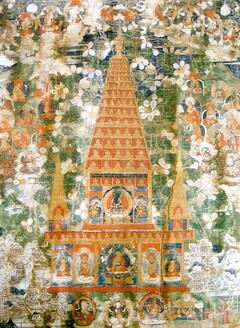Brief Consecration Ritual
༄༅། །རྟེན་གསུམ་རབ་ཏུ་གནས་པའི་ཆོ་ག་སྙིང་པོར་དྲིལ་བ་བཞུགས་སོ། །
A Brief Consecration Ritual for Representations of Enlightened Body, Speech and Mind
by Dodrupchen Jikmé Tenpé Nyima
སྐྱབས་སེམས་སྔོན་དུ་བཏང་ནས།
Begin with refuge and bodhicitta. Then:
རང་ཉིད་སྐད་ཅིག་གིས་དཔལ་ཧེ་རུ་ཀའི་སྐུར་གྱུར།
rang nyi ké chik gi pal heruké kur gyur
In an instant, I transform into the glorious heruka.
ལྷག་པར་གནས་པའི་ཆོ་ག་ལ་བར་དུ་གཅོད་པའི་ལོག་འདྲེན་བགེགས་ཀྱི་རིགས་ཐམས་ཅད་འདིར་མ་འཁོད་པར་གཞན་དུ་དེངས་ཤིག །
lhakpar népé choga la bar du chöpé lok dren gek kyi rik tamché dir ma khöpar zhen du deng shik
All you obstacle makers and disruptive influences who seek to obstruct this ritual of consecration do not remain here, but go elsewhere!
ཧཱུྃ་བཞིའི་སྔགས་བརྗོད།
Recite the mantra of the four hūṃs.
བཛྲ་རཀྵ་རཀྵ་ཧཱུྃ།
bendza raksha raksha hung
vajra rakṣa rakṣa hūṃ
སྟེང་འོག་ཕྱོགས་མཚམས་ཐམས་ཅད་རྡོ་རྗེའི་རྭ་བ་དང་གུར་ཁང་གིས་མཚམས་བཅད་པར་གྱུར།
teng ok chok tsam tamché dorjéi rawa dang gur khang gi tsam ché par gyur
The space above, below and in all directions is now enclosed within a fence of vajras and a protective tent.
ཨོཾ་མ་ཧཱ་ཤཱུ་ནྱ་ཏཱ་ཛྙཱ་ན་བཛྲ་སྭ་བྷཱ་ཝ་ཨཱཏྨ་ཀོ྅ཧཾ།
om maha shunyata jnana benza svabhava atma ko ham
oṃ mahā-śūnyatā-jñāna-vajra-svabhāvātmako ’ham
སྟོང་པ་ཉིད་ཀྱི་ངང་ལས་སྒྱུ་མ་ལྟ་བུའི་ཡེ་ཤེས་ཀྱི་རྩལ་སྣང་དག་པ་རབ་འབྱམས་བརྟན་གཡོའི་འཁོར་ལོར་ཅིར་ཡང་འཆར་བའི་དམ་ཚིག་གི་རྟེན་རྣམས་བཅོམ་ལྡན་འདས་རྡོ་རྗེ་འཆང་སྐུ་མདོག་སྔོན་པོ་རྡོ་རྗེ་དང་དྲིལ་བུ་འཛིན་ཅིང་ལོངས་སྤྱོད་རྫོགས་པའི་ཆོས་ཀྱིས་བརྒྱན་པ་ཞབས་རྡོ་རྗེའི་སྐྱིལ་ཀྲུང་དུ་བཞུགས་པའི་གནས་གསུམ་ཡི་གེ་གསུམ་གྱིས་མཚན་པ་ལས་འོད་ཟེར་འཕྲོས་འོག་མིན་གྱི་ཞིང་ནས་ཡེ་ཤེས་སེམས་དཔའི་ཚོགས་བཛྲ་ས་མ་ཡ་ཛཿ
tongpa nyi kyi ngang lé gyuma tabüi yeshé kyi tsal nang dakpa rabjam ten yöi khorlor chir yang charwé damtsik gi ten nam chomden dé dorjé chang ku dok ngönpo dorjé dang drilbu dzin ching longchö dzokpé chö kyi gyenpa zhap dorjéi kyil trung du zhukpé né sum yigé sum gyi tsenpa lé özer trö omin gyi zhing né yeshé sempé tsok bendza samaya dza
Out of the state of emptiness, as the dynamic expression of illusion-like wisdom arises the infinite purity of the environment and beings manifest as the supports of our samaya in the form of the transcendent conqueror Vajradhara, blue in colour and holding a vajra and bell. He is adorned with all the marks of a saṃbhogakāya buddha, and is seated in the vajra posture. At his three centres are the three syllables oṃ, āḥ and hūṃ, from which there emanate rays of light to invoke the wisdom deities of the buddha field of Akaniṣṭha. Vajra samaya jaḥ!
Make offerings with:
ཨོཾ་བཛྲ་ཨརྒྷཾ་པཱདྱཾ་པུཥྤེ་དྷཱུཔེ་ཨཱ་ལོ་ཀེ་གནྡྷེ་ནཻ་ཝ་དྱ་ཤཔྡ་པྲ་ཏཱི་ཙྪ་སྭཱ་ཧཱ་ཀྱིས་མཆོད།
om benza argham padam pupé dhupé aloké gendhé nevidé shabta pratitsaya soha
oṃ vajra arghaṃ pādyaṃ puṣpe dhūpe āloke gandhe naivedye śabda pratīccha svāhā
Then offer praise with:
བསྟོད་པར་འོས་པ་ཐམས་ཅད་ལ། །
töpar öpa tamché la
With bodies as numerous as atoms in the universe,
ཞིང་རྡུལ་ཀུན་གྱི་གྲངས་སྙེད་ཀྱི། །
zhing dul kun gyi drang nyé kyi
And with the most intense devotion,
ལུས་བཏུད་པ་ཡིས་རྣམ་ཀུན་ཏུ། །
lü tüpa yi nam kun tu
We offer homage and prostrations
མཆོག་ཏུ་དད་པས་ཕྱག་འཚལ་བསྟོད་ཀྱིས་བསྟོད་ལ།
chok tu dépé chak tsal tö
To all those who are worthy of praise.
ཛཿཧཱུྃ་བཾ་ཧོཿ
dza hung bam ho
jaḥ hūṃ baṃ hoḥ
དམ་ཡེ་དབྱེར་མེད་དུ་གྱུར་པའི་ཐུགས་ཀ་ནས་འོད་ཟེར་འཕྲོས་དབང་གི་ལྷ་རིགས་ལྔ་འཁོར་བཅས་སྤྱན་དྲངས།
dam yé yermé du gyurpé tukka né özer trö wang gi lha rik nga khor ché chen drang
From the heart of the indivisible union of samayasattva and jñānasattva there emanate rays of light, which invoke the empowerment deities of the five families together with their retinues, who then bestow empowerment with:
ཨོཾ་སརྦ་ཏ་ཐཱ་ག་ཏ་ཨ་བྷི་ཥེ་ཀ་ཏེ་ས་མ་ཡེ་ཤྲི་ཡེ་ཧཱུྃ༔
om sarwa tathagata abhishekaté samayé shriyé hung
oṃ sarva tathāgata abhiṣekate samaya śrīye hūṃ
ཞེས་དབང་བསྐུར།
སྐུ་གང་དྲི་མ་དག་ཆུའི་ལྷག་མ་ཡར་ལུད་པ་ལས་རིགས་ལྔའི་ཅོད་པན་གྱིས་དབུ་བརྒྱན་པར་གྱུར།
ku gang drima dak chüi lhakma yar lüpa lé rik ngé chöpen gyi u gyenpar gyur
All impurities of the body are purified. The remaining water gathers to create the crown of the five families adorning the head.
ཨོཾ་ཙཀྵུ་ཙཀྵུ་ས་མཱནྟ་ཙཀྵུ་བི་ཤྭ་དྷ་ནི་སྭཱ་ཧཱ།
om tsakshu tsakshu samanta tsakshu bishodhani soha
oṃ cakṣu cakṣu samanta cakṣu viśodhane svāhā
ཨོཾ་ཨཱཿཧཱུྃ།
om ah hung
oṃ āḥ hūṃ
ལན་གསུམ།
Three times
བསྒོམས་པའི་ལྷ་རྣམས་འོད་དུ་ཞུ་བ་ལས་རྟེན་སོ་སོའི་རྣམ་པར་གྱུར།
gompé lha nam ö du zhuwa lé ten so söi nampar gyur
The visualized deities melt into light and transform their appearance into that of the various representations [of enlightened body, speech and mind].
བརྟན་བཞུགས་ནི།
The Request to Remain
ཕྱོགས་བཅུ་ན་བཞུགས་པའི་སངས་རྒྱས་དང་བྱང་ཆུབ་སེམས་དཔའ་ཐམས་ཅད་བདག་ལ་དགོངས་སུ་གསོལ།
chok chu na zhukpé sangyé dang chang chub sempa tamché dak la gong su sol
All you buddhas and bodhisattvas who dwell throughout the ten directions, think of us!
ཇི་སྲིད་ནམ་མཁའི་མཐའ་དང་མཉམ་པའི་སེམས་ཅན་ཐམས་ཅད་མི་གནས་པའི་མྱ་ངན་ལས་འདས་པའི་ས་ལ་མ་བཞག་གི་བར་དུ་རྒྱལ་བ་རྣམས་མྱ་ངན་ལས་མི་འདའ་བར་བརྟན་པར་བཞུགས་སུ་གསོལ།
ji si namkhé ta dang nyampé semchen tamché mi népé nya ngen lé dépé sa la ma zhak gi bar du gyalwa nam nya ngen lé mi dawar tenpar zhuk su sol
Until all beings, as infinite as space itself, are brought to the state of perfect nirvāṇa beyond extremes, may you victorious ones remain here constantly, without passing into nirvāṇa!
ཁྱད་པར་དུ་ཡང་སྐུ་གསུང་ཐུགས་ཀྱི་རྟེན་འདི་རྣམས་ལ་ཇི་སྲིད་འབྱུང་བ་བཞིའི་གནོད་པས་མ་ཞིག་གི་བར་དུ་བརྟན་པར་བཞུགས་སུ་གསོལ།
khyepar du yang ku sung tuk kyi ten di nam ji si jungwa zhi’i nöpé ma zhik gi bar du tenpar zhuk su sol
In particular, may you remain here until these representations of enlightened body, speech and mind are destroyed by the four elements.
བརྟན་པར་བཞུགས་ནས་ཀྱང་བདག་དང་སེམས་ཅན་ཐམས་ཅད་ལ་མཆོག་དང་ཐུན་མོང་གི་དངོས་གྲུབ་མ་ལུས་པ་སྩལ་དུ་གསོལ།
tenpar zhuk né kyang dak dang sem chen tamché la chok dang tün mong gi ngö drup ma lü pa tsal du sol
And, as you remain here, may you grant us and all other beings all the supreme and ordinary siddhis!
དབྱངས་གསལ་རྟེན་སྙིང་ཅི་རིགས།
Recite the vowel and consonant mantras and the essence of dependent origination as many times as possible. Then:
འདིར་ནི་གཟུགས་དང་ལྷན་ཅིག་ཏུ། །
dir ni zuk dang lhen chik tu
Remain here, one with these images and objects,
འཁོར་བ་སྲིད་དུ་བཞུགས་ནས་ཀྱང་། །
khorwa si du zhuk né kyang
Until samsara comes to an end;
ནད་མེད་ཚེ་དང་དབང་ཕྱུག་དང་། །
né mé tsé dang wangchuk dang
Grant us freedom from illness, long life, power and prosperity, and
མཆོག་རྣམས་ལེགས་པར་བསྩལ་དུ་གསོལ། །
chok nam lekpar tsal du sol
Make everything supremely auspicious: we pray!
ཨོཾ་སུ་པྲ་ཏིཥྛ་བཛྲ་ཡེ་སྭཱ་ཧཱ།
om supratishta bendzayé soha
oṃ supratiṣṭha-vajraye svāhā
མཐར་ཤིས་བརྗོད་བྱའོ། །
To conclude, recite verses of auspiciousness.
ཞེས་པའང་རིགས་ཀྱི་གཅུང་པོ་འཛམ་གླིང་དབང་རྒྱལ་གྱི་གསུང་ངོར་འཇིགས་མེད་བསྟན་པའི་ཉི་མས་སྐད་ཅིག་གིས་ཤར་མར་བྲིས།། །།
In response to a request from Dzamling Wangyal,1 the elder brother of my family, Jikmé Tenpé Nyima instantly wrote down whatever came to mind.
| Translated by Adam Pearcey, 2007.
Source: 'jigs med bstan pa'i nyi ma. "rten gsum rab tu gnas pa'i cho ga snying por dril ba/" in rDo grub chen ’jigs med bstan pa’i nyi ma’i gsung ’bum. 7 vols. Chengdu: Si khron mi rigs dpe skrun khang, 2003. TBRC: W25007, vol. 4: 117–119
Version: 1.4-20221128
- ↑ Khyentse Tulku Dzamling Wangyal (1868-1907), a tulku of Do Khyentse. He was the eldest of Dodrupchen Rinpoche’s seven younger brothers.
